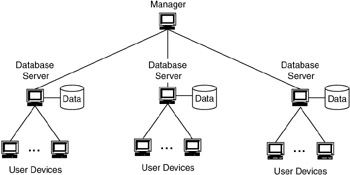4.12 Exercises
4.12 Exercises
-
Show flows for each set of devices and applications listed here. Label each as either a unidirectional or a bidirectional flow.
-
Client-server application: downstream (from server to client), 1.2 Mb/s capacity; upstream (from client to server), 15 Kb/s capacity
-
Streaming video (User Datagram Protocol) from video server to a subscriber's PC: 300 Kb/s capacity, 40-ms delay (one way).
-
Downloading pages from the Web: downstream, 250 Kb/s capacity, 5-second delay; upstream, 100 Kb/s capacity
-
Transaction processing from point-of-sale (PoS) machine to server: upstream (from PoS machine to server), 30 Kb/s capacity, 100-ms round-trip delay; downstream, 50 Kb/s capacity
-
-
Devices can act as both data sources and data sinks depending on the application and flow. Which of the following devices (for the applications given) are data sinks? Which are data sources?
-
A storage device receiving streaming video from a camera
-
A video-editing unit, using video from the storage device in part a
-
A Web server and its clients
-
A storage disk farm
-
-
Which flow models apply to each set of flows described here?
-
Users on the Internet accessing the same Web server
-
Forty workstations processing batch jobs overnight, managed by a central mainframe
-
Email use across the Internet
-
A transaction-processing application, authorizing credit card transactions between a company's retail stores and its headquarters
-
-
For each of the examples in Exercise 3, give the most likely direction(s) for the flows described by each flow model.
-
Develop a flow model for real-time/near-real-time flows. How would you characterize the flows for this model? What are likely data sources and sinks? Apply your model to a video conferencing application.
-
You are developing a network for a company's online transaction-processing (OLTP) application (e.g., a retail sales network). Its current system is a mainframe that has several terminals connected to it, either directly or through a terminal server, as in Figure 4.51. The company is moving to a hierarchical client-server network, where there will be multiple regional database servers, each acting in a client-server fashion and updating each other's regions via a database manager, as in Figure 4.52.

Figure 4.51: Mainframe environment for OLTP application.
Figure 4.52: Hierarchical client-server environment for OLTP application.-
Show the probable data sources and sinks for both environments.
-
How does migrating from the mainframe environment to the hierarchical client-server environment modify the traffic flows in the network?
-
In what ways does the network environment improve the traffic flows?
-
What are some of the potential trade-offs between the two environments, for example, in security, management, and performance?
-
EAN: 2147483647
Pages: 161